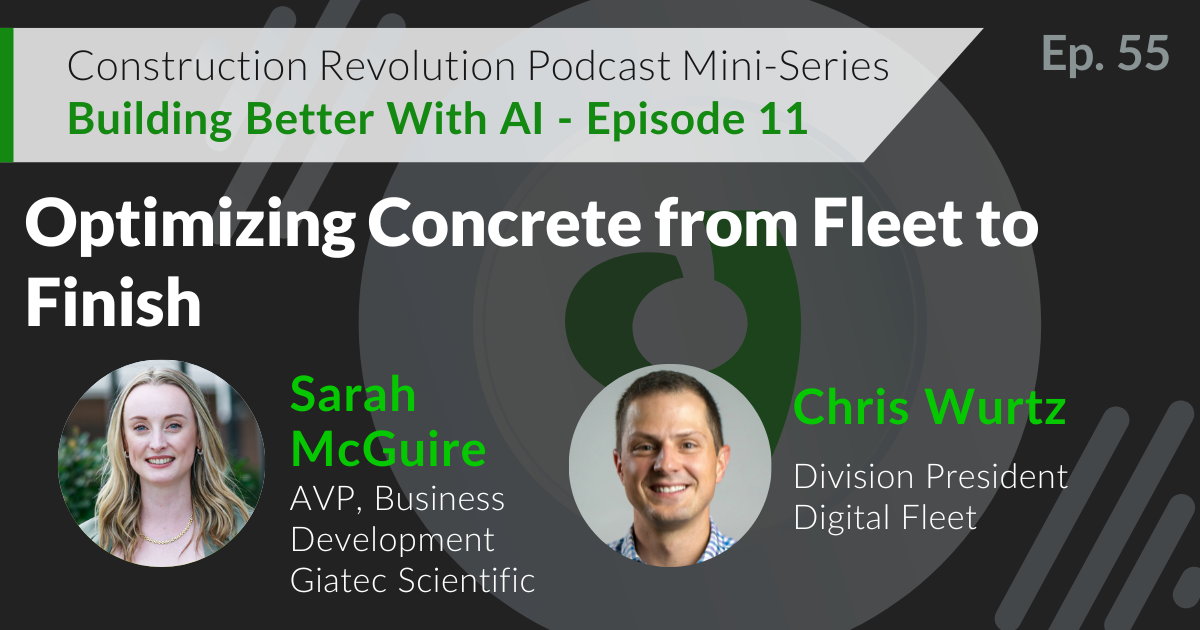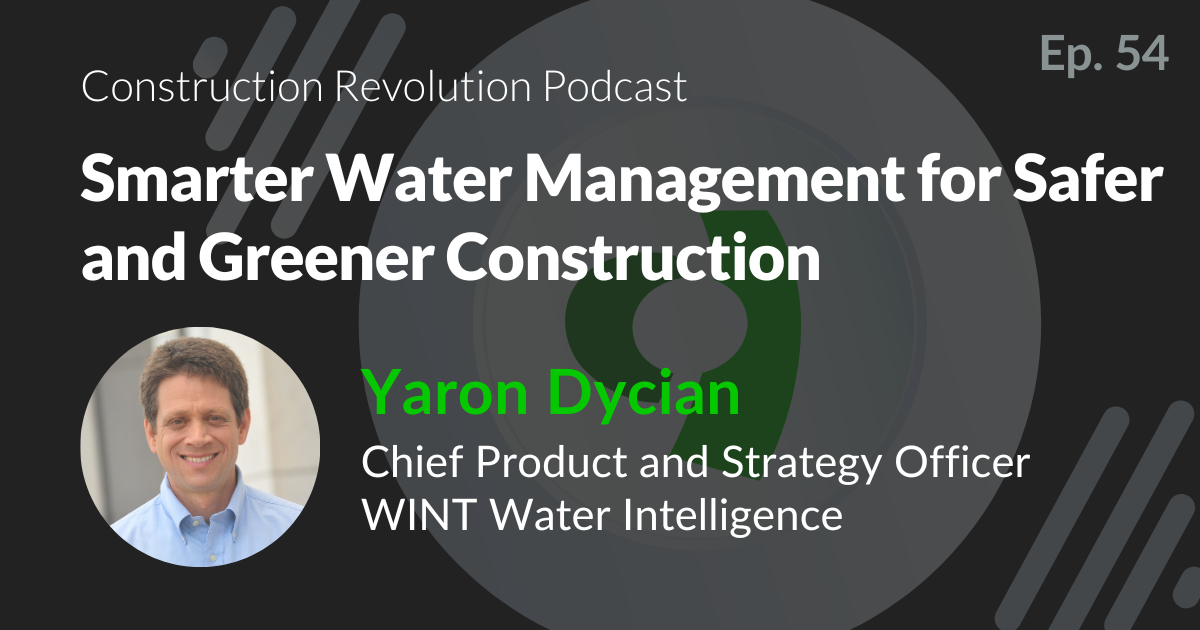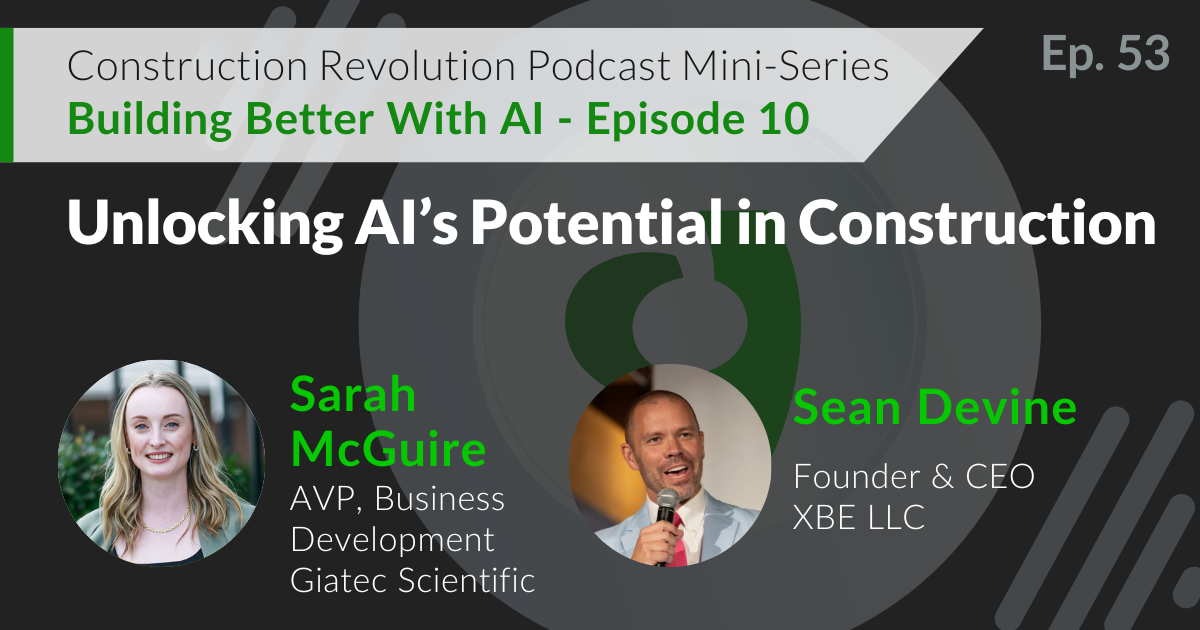
Episode 32 |
October 5, 2023
Digitizing the Worksite Layout Process
In This Episode
In this episode of The Construction Revolution Podcast, we sit down with Tessa Lau, the Founder and CEO of Dusty Robotics. Holding a PhD in Machine Learning with an emphasis on Human-Computer Interaction, Tessa has dedicated her career to finding innovative solutions for traditional industries. After transitioning away from her previous start-up, Savioke, she set her sights on revolutionizing the construction industry with Dusty Robotics.
The Dusty Robotics FieldPrinter automizes the layout process by printing the markings in a single pass, increasing accuracy and efficiency, and reducing the need for strenuous labor. This not only reduces the risk of workplace injuries, but it also frees up time for employees to complete other tasks. Tune in to learn more about Dusty Robotics and how it is automating the construction layout process.

Host
Steven Rossi-Zalmons
Marketing & Events Lead, Giatec Scientific Inc.

Guest
Tessa Lau
Founder & CEO, Dusty Robotics
Podcast Transcript
Steven Rossi-Zalmons:
Hello there and welcome to the Construction Revolution podcast. My name is Steven Rossi and here on the show we explore the latest trends, technologies, people, and organizations that are revolutionizing or disrupting the construction industry and are changing what the industry will look like tomorrow.
Today on the show I’m speaking with Tessa Lau, the founder and CEO of Dusty Robotics. Prior to starting Dusty Robotics, Tessa worked in the field of machine learning and robotics as a researcher before starting another company that developed the world’s first hotel delivery robot. In 2018, Tessa founded Dusty Robotics. Once again, revolutionizing traditional processes with robotics by completely updating the construction industry’s design, build, operate lifecycle. Through its robot powered tool Field Printer, the company aims to bridge the gap between traditional construction and digitized manufacturing. We’ll discuss how the Field Printer works and how it can help save you time and money on your projects. Tune in to learn more about how Dusty Robotics is working towards revolutionizing the construction industry through robotics and automation.
Hi Tessa, thanks for joining me today. How’s it going this morning?
Tessa Lau:
Oh, it’s going great, Steven. I’m happy to be here.
Steven Rossi-Zalmons:
So yeah, I’m really excited to have you on and learn more about you as well as Dusty Robotics and as well as some of the previous experience you’ve had as well. You’ve had a really interesting background and career and I’m excited to get to know more.
Tessa Lau:
Absolutely. Happy to share.
Steven Rossi-Zalmons:
Great. So let’s start off in, can you tell me a bit more about the origins of Dusty Robotics and where you sort of got the idea to start the company?
Tessa Lau:
So I’ve been in robotics for, gosh, probably over 10 years now. And I had previously a CTO and co-founder of another robotics company, Savvy Oak. We were building robots for the hospitality industry, think R2-D2 robots that would deliver room service to guests staying in hotels. And the challenge that I saw, I was there for five years and it wasn’t really taking off. We had a cool product, it was like a novelty, but it wasn’t really solving pain points. And so when I decided to start a new company, I was looking around for areas and industries where robotics would really make a difference. And I happened upon construction because I just finished a house remodel and I had hired a general contractor and he was sending people to my house with hand tools on their hands and knees doing manual labor.
And I realized that construction is so inefficient and it’s still inefficient. It’s 2018 and it’s still done by skilled labor. And so I thought there must be an opportunity to introduce robotics and automation into this industry. And so I bought a hard hat and steel-toed boots. I didn’t know anything about construction, but I started walking around on construction sites and talking to people and learning everything I could about this industry. I found lots of opportunities, places to introduce robotics and when I saw people on their hands and knees snapping chalk lines, I realized that that was a really good opportunity to inject some automation to streamline and make that layout workflow a lot more efficient and less error-prone. And so that’s where Dusty came about.
Steven Rossi-Zalmons:
Yeah, that’s awesome. Yeah, construction is definitely, especially in 2018, I’m sure it had lots of room for automation and robotics and still today. But it’s great that there’s companies like yours who are starting to change that and to improve the industry. So I’m wondering, you sort of touched on that you were working on a different company in hospitality and different robotics. I’m wondering how your experience at there sort of helped you with starting this company.
Tessa Lau:
Yeah, so I learned a lot about starting a robotic startup, building robots, getting them out into the field. And I think the biggest learning that I took away from Savvy Oak was that you want to figure out what the product is before you launch the company. Because the mistake that we made there was building the technology first and then trying to find a market for it. So we built the first relay robot without having talking to any hotel professionals to really understand what their pain points were. And so at Dusty when we started the company, we did six months of customer research and discovery before committing to building what would now become the Field Printer. And we wanted to make sure that we were solving the right problem for the right person and that people would be willing to pay for it before starting to devote any resources to it.
Steven Rossi-Zalmons:
Yeah, absolutely. Yeah, that’s definitely a great approach and great learning for anyone who’s considering starting a business. That’s really important to test your market before you dedicate any resources heavily. So can you explain what the Field Printer is and who gets the most benefit out of it on job sites?
Tessa Lau:
So the Field Printer is, imagine a vacuum cleaner robot. So a very small Roomba size device that has a printer strapped to it and it goes around on the floor and it draws the BIM models or the blueprints of your building on the floor so that everyone, all the trades can come in and build exactly what they’re supposed to. And we do this about 10 times faster than the traditional method for doing layout. And we’re doing it with all trades information at once rather than the traditional method of each trade gets the floor for a period of time, does their layout, and then hands it off to the next trade. And so the biggest benefit that our customers are seeing are from general contractors who are using this to do multi trade layout and they’re seeing huge schedule compression. What that means is that instead of the traditional process taking multiple weeks to have all the trades come through and do their layout on the floor, and you can’t start building until your layout is down.
And so you can imagine holding the floor clear for that significant period of time is a hardship. Dusty is doing that same job of getting all of those trades’ layout down on the ground in a small number of days. So a job that we just recently did for Truebeck here in the Bay Area, they had several weeks in the schedule, three to four weeks in the schedule for traditional layout. We compressed that with Dusty down to about three days. So that’s a significant schedule savings and the trades can start building on the floor immediately after the robot comes through. So you don’t even have to wait for the robot to complete the entire floor. Starting on the second hour of robot printing, the trades can come through right behind it on its tail and start doing their installation work. And so that creates a lot more time in the schedule or it enables our customers to deliver buildings a lot faster than they would otherwise.
Steven Rossi-Zalmons:
Yeah, that’s awesome. Yeah, in construction, obviously time is probably the most important resource and the savings that come along with saving time are immense from a monetary perspective as well. So yeah, I could see how valuable that would be. I was looking on the website about the Field Printer and I saw some videos of, looked like someone sort of standing there with a remote and a controller. I was wondering, is the Field Printer, is it self automated? Do you stand there with sort of a controller? How does it work?
Tessa Lau:
Yeah, so we call it semi-automated. So what that means is that a person, so our operators are typically foreman or superintendents or sometimes journeymen or apprentices on the job site. And their responsibility is to set up the equipment. So it’s similar to setting up a total station. You scan in control, you position your device and then you tell the robot what to print. And you do that by selecting lines on this tablet interface that holds your drawings, your CAD files or your Revit model.
And so it shows you what layout needs to be printed. You can use your finger to select a portion of that layout and then you hit go. And then from then on the robot is autonomous and it will figure out the best order in which to print those lines. It will detect obstacles, work its way around them and give you as complete coverage as it can over that area that you’ve selected. But the human is in the loop because construction sites are chaotic and there’s always someone telling you, oh, you can’t be here. I need to do my work here. So you need to go over there. And so that person is responsible for directing the robot’s work so that it does the right thing in the right place.
Steven Rossi-Zalmons:
Nice. If I was a foreman on a job site, what would be the process like to learn the technology and become qualified or be confident enough to operate it on the job site?
Tessa Lau:
So training is included as part of our annual subscription packages. And when we train, we actually send one of our customer success managers out to the field who will teach that foreman how to use the system. So training usually takes around four days. Sometimes if they’re familiar with total stations, it takes a lot less because a lot of that is spent teaching control and stationing and just basic total station operation. And as soon as they get started, they can actually start printing. So typically we’ll do training on a live job site and within the first few hours our trainees are starting to produce production layout.
Steven Rossi-Zalmons:
Yeah, I can see how having someone there on site, that’s a great way to make sure that everything’s going smoothly. And then another question I had on the Field Printer is how many printers do you normally use on one job site? Like for big sites, are people using one on every floor at the same time or do you sort of do one floor and then move it up? How does that work?
Tessa Lau:
Yeah, so we typically are, we’re constrained by construction schedules. So on a typical cast in place tower with multiple stories, those floors only become available once a week or so. And so once the floor is available, you’ll deploy Dusty on it. Because we’re so much faster, we’ll typically finish laying out that floor in like a day and then we’ll go onto the next floor a week later and so on. But what we have seen is that on really large projects, things like data centers or warehouses, we’ve actually had our clients deploy up to four robots on the floor at the same time. And all that means is that you can forex your productivity and just get the job done a lot faster than you would otherwise.
Steven Rossi-Zalmons:
Yeah, absolutely. And in those cases, do the robots, are they interacting with each other or you sort of just assign them? You split the floor into floor?
Tessa Lau:
Yeah, you split the floor. So each robot gets a quadrant, let’s say.
Steven Rossi-Zalmons:
Okay, nice. So you sort of touched on this a little bit before, but I’m wondering before Field Printer, what was sort of the process like for mapping out the floor plans and the BIM models?
Tessa Lau:
So it kind of varies by trade. The bulk of layout, probably about 70% of the layout on a typical commercial building is drywall. So we’re laying out the locations of the walls and soffits and things like that. And drywall layout is typically done using chalk and string. So that process was actually invented by the early Egyptians about 5,000 years ago to build the pyramids and it’s still in use today. So imagine someone on the floor with printed plans, shop drawings with dimensions on them. They’re taking a measuring tape, getting down on the ground, measuring three feet off of this column, two feet off of that feature, and then stretching out a piece of string between two points and snapping it to create a line. That’s how layout is done today for the vast majority of framing contractors.
Steven Rossi-Zalmons:
Yeah, that’s hard to believe that we’re still using a model like that. So another thing I was curious, you mentioned obviously job sites are very chaotic and I guess the operator is sort of in charge of helping to navigate around that. But I’m also wondering what you’ve done from a coding and in terms of developing the technology to be prepared for the chaos that is on a job site?
Tessa Lau:
What we’ve done at Dusty is we’ve been constantly learning from our customers and how they use Dusty in order to add more features to our robot to make it better and more useful on the chaos of job sites. And one example of that is, so we use a laser tracker, it’s like a total station, but higher end, has more precision and accuracy and it’s better for tracking moving targets. And so that laser tracker, imagine it sits on a tripod, it’s like a laser turret that sits on a tripod, points a laser beam at our robot and measures the location of the robot. That’s how the robot knows where it is. So you station the laser tracker, like you station a total station, and then it tells you exactly where your robot is and that’s how the robot knows what to do and where to print because it’s receiving its location.
So you can imagine on the chaos of a job site, there are people moving around, there are people moving materials around, there are people carrying two by fours over their shoulder and they’re not looking carefully about where they’re swinging those pieces of wood. And so, one of the things that happens is occasionally your laser tracker or total station gets bumped and when it does, all of the measurements that it makes subsequent to being bumped are no longer valid. And when this happens, it means that everything that the robot prints after that bump is no longer accurate. And obviously that causes a problem because you need accuracy. That’s the whole reason we exist. Accuracy for us is table stakes. And so what we’ve done in response to that is we’ve come up with a solution involving backcheck reflectors. So imagine you can put down prisms or reflectors at known locations in the environment, you just glue it onto a wall or stick it down somewhere onto a column.
And then every so often, our positioning device measures the position of that reflector. Has it moved? Reflector hasn’t moved because it’s fixed in place. So if that measurement is no longer the same as what it was before, that probably means that your laser tracker was bumped. And that means that you need to stop reposition, restation and do that before you continue work. Otherwise, everything that you do is going to be suspect. And so in response to what we’ve learned about what can actually happen on job sites, we’ve had to develop these solutions that actually allow our customers to keep using our product and keep guaranteeing that accuracy that they need.
Steven Rossi-Zalmons:
Yeah, that’s really interesting. So I know that right now Dusty is only available in the US, is that correct?
Tessa Lau:
That is true.
Steven Rossi-Zalmons:
So obviously there’s applications to this around the world. I’m wondering what your plans are to sort of expand internationally.
Tessa Lau:
So right now we’re US only, we have an enormous amount of interest all around the world. Just like naming a couple of regions from Europe, Australia, Asia, Middle East, South America. We’re getting interest from all over the place. And the constraints that we have are that we’re still a small team and our product can only be used in the US right now. By analogy, think about cell phones. When you buy an iPhone or an Android phone, you have a different model for the different regions, and that’s because of the radio frequencies used inside the cell phone. Well, we’ve built the US model of our robot. Because it uses radio, we need a different part, different set of frequencies and a slightly different model in order to operate in the other countries. So we’ll get there eventually and we would love to expand, but not this year.
Steven Rossi-Zalmons:
Yeah, that makes sense. So in terms of expanding not only into your region, but just looking ahead, what are some sort of key milestones or new features or things that Dusty is working on right now and how do you see the product and also the company sort of evolving over the next few years?
Tessa Lau:
So that’s a number of different questions. Let me start at the goal and work our way backwards. So I want Dusty to become a generational company. I want Dusty products to be used on construction sites for generations. And in order to do that, we are going to develop a family of solutions, most likely robotic solutions that all increase the efficiency of the construction industry. Just like we have done with the Field Printer, we’re going to do for other parts of the construction workflow. We are not doing that anytime soon because I need my team to focus on getting this Field Printer out to market. We are still fine-tuning it, we’re still learning from our customers, we’re still improving it. Massively every month we have a new release that generates a lot of features that our customers have been asking for. And so our team’s focused on that right now.
But let me share with you one of the things that’s coming soon that I’m really excited about. So we just recently built the ability to print QR codes and our customers are starting to use this as part of their workflows. So there’s a framing contractor out in Michigan called Belmar, and they just posted a little clip on LinkedIn about how they’ve used Dusty to print QR codes next to their walls. And these QR codes give them information about the wall types that are going to be installed in that location. And the reason that’s interesting is because we are starting to link locations in the physical world with information in the digital world. There’s all this information in the digital world about what you’re going to build, what the part numbers are, what the installation instructions are, what things to pay attention to as you’re doing that installation and construction.
And right now it’s not accessible to anyone in the field unless the foreman reads that documentation and tells it to the workers and who are actually doing the work. And so through printing QR codes, we can actually bring some of that information out into the field where people need it and it’s going to be right underfoot and it’s going to be customized to them, to their role, to their stage in construction, to their trade and give them the information they need at their fingertips. It also knows exactly where they are because we know where those QR codes are that we’re printing, and so that information is customized to their location. And so all of that is going to enable our contractors to build better by bringing information right underfoot.
Steven Rossi-Zalmons:
Yeah, absolutely. Yeah, that’s awesome. I can see how useful that would be and I’m sure that’s a really exciting feature for all your existing customers as well. So also just obviously you’ve been in robotics and sort of thing for a long time. I’m wondering what sort of innovative technologies that you’ve seen not only out there in general that you could see impacting the construction industry in the next few years?
Tessa Lau:
So where I’m seeing the most robotics in construction, aside from Dusty of course, is in offsite manufacturing and the use of robots to actually do building work. That is one of the directions that I think is actually going to be successful and it’s going to be assisted by robotic layout. Because the reality is if you’re prefabbing stuff offsite, you bring it to the site, it’s got to fit. You don’t have the room to fudge things or to cram things in where they wouldn’t otherwise work because everything is just built so tightly to tolerance. And so it’s a natural fit for robotic layout. And together the two of those technology components enable a fully paperless digital workflow, which I find really, really interesting. So imagine you design your building and software, you send those software designs off to manufacturing to get your walls or your components prefabbed.
You have a robot lay out exactly where all those components are going to be on the job site, and you can build that entire thing without committing anything to paper. And paper is problematic because it’s obsolete as soon as you print it. Everything’s changing, everything’s evolving. There’s so much richness of information that you don’t necessarily have on that single piece of paper. And so by eliminating paper from that digital workflow, not only were we saving a bunch of trees, we’re also really enabling the digitization of the construction industry. Which helps everyone move a lot faster with a lot more precision and fewer mistakes.
Steven Rossi-Zalmons:
Absolutely. Yeah. That’s really interesting. And I think to your point of digitizing the construction industry, I know a lot of people in the industry have a fear that that could lead to job replacement with the things like robots and other automation tools. I’m wondering what Dusty’s approach when you get that sort of pushback from people, what is your response to that?
Tessa Lau:
The reality is robots are taking jobs and the jobs that they’re taking are the ones that no one wants to do. We do a fireside chat program at Dusty, and so we bring in someone from the industry about once a quarter to talk to us about their experience, both traditionally and then after we introduced Dusty. And so Evan Masters from Southland Industries was in here yesterday talking to us about his use of Dusty. He’s a journeyman with the sheet metal union. And his comment about what is the biggest impact that Dusty made on your life is his back. He said it no longer hurts.
And that’s because prior to Dusty down, he was the guy using a total station in this case to do point layout. It’s a very arduous task. You have to stand really still. You have to position the device really carefully. You can’t move. You’re really tense. And then there’s the other guy who’s down on his hands and knees making the marks on the ground of where those points should go. Imagine that toll that takes on people’s bodies. We’re getting rid of that job. Evan still has a job. He’s now the robot operator. And in fact, Evan is now teaching people how to use Dusty. And so by getting rid of some of those unpleasant backbreaking jobs, we’re creating more jobs with people who are now leveraging technology and helping others incorporate that into their lives as well.
Steven Rossi-Zalmons:
Yeah. Yeah, that’s it. That’s great. I think that’s a great approach that it’s not necessarily that we’re… We may be eliminating a job, but we’re not eliminating jobs total. That the people will have a different job, that they’ll probably enjoy more and they’ll be more efficient doing whatever they’re doing with the technology that’s now in place.
Tessa Lau:
Exactly.
Steven Rossi-Zalmons:
So just to wrap up, if someone wants to get started with Dusty and the Field Printer, where do they go and what does that process look like?
Tessa Lau:
Yeah, so we would love to talk to you if you’re interested in learning more about Dusty, start with our website, dusty robotics.com. We also have a lot of videos on our YouTube channel if you want to see it in action or hear some of our customers talk about why they’re using Dusty. And if you want to reach out to us sales@dustyrobotics.com is your best bet. I’ll see it as well as our sales team, and we’re happy to have a conversation.
Steven Rossi-Zalmons:
Tessa, thank you again for joining me today. It was great to learn more about you and about Dusty as well.
Tessa Lau:
Thank you for having me, Steven. It’s been a blast.
Other Related Episodes
Episode 55 |
February 27, 2025
Optimizing Concrete from Fleet to Finish
In this latest episode, host Sarah McGuire speaks with Chris Wurtz, Division President at Digital Fleet, about the impact of data-driven decision-making in the ready-mix concrete industry. With expertise in fleet tracking technology, Chris sheds light on the challenges and opportunities of controlling what he calls a “factory on wheels”—the mixer truck. He explores the biggest obstacles facing producers today, from data limitations to inefficiencies in delivery, and highlights untapped opportunities to improve performance. Chris also discusses the vision behind Digital Fleet’s partnership with Giatec on MixPilot and how this integration is helping producers gain better control over their operations. Tune in for an insightful conversation on the future of ready-mix operations and how collaboration between technology providers is driving industry-wide transformation. Don’t miss this engaging discussion!
PLAY
Episode 54 |
February 6, 2025
Smarter Water Management for Safer and Greener Construction
In this episode of The Construction Revolution Podcast, Steven Rossi sits down with Yaron Dycian, Chief Product and Strategy Officer of WINT Water Intelligence. With over 25 years of experience driving strategy and innovation at leading companies like IBM and RSA, Yaron is leading the charge in AI-powered water management solutions. Tune in as Yaron shares the story of WINT, explores the rising challenges of water damage claims, and discusses how advanced monitoring and leak mitigation technologies are shaping the future of construction. From preventing costly damages to meeting sustainability standards and lowering carbon footprints, this episode offers valuable insights into how construction companies can stay ahead in a rapidly evolving industry.
PLAY
Episode 53 |
December 12, 2024
Unlocking AI’s Potential in Construction
In this latest episode, host Sarah McGuire sits down with Sean Devine, Founder and CEO, XBE, to explore the transformative role of AI in the construction industry. With a background in logistics and technology, Sean brings unique insights into the challenges and opportunities surrounding AI adoption in construction. Sean highlights untapped opportunities and discusses how XBE is leading the charge with innovative solutions, including AskConcrete— a groundbreaking answer engine powered by decades of NRMCA data, designed to tackle complex questions about ready-mixed concrete. From identifying industry limitations to exploring what companies need to do to embrace AI effectively, Sean offers a compelling roadmap for innovation. He also shares his journey in founding XBE and his mission to optimize heavy construction operations with cutting-edge technology. Tune in to gain valuable insights into how AI is shaping the future of construction. Don’t miss this enlightening discussion!
PLAY
Want to Be a Guest Speaker, Sponsor, or Just Have a Question for Us? Fill In the Form!




